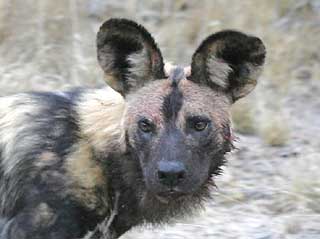Specialized Pack System
African wild dogs (Lycaon pictus) have evolved a highly specialized pack system that allows them to hunt more efficiently.
As a result they're usually sighted in a group - whether at rest, at play, or setting off on a hunt - rather than individually.
This social system works for and against getting good photographs of wild dogs.
Because they stay in packs and can travel quickly over great distances, when they move off they all go and disappear totally.
But if they're in your area and there's enough prey to feed them, then there should be good photo opportunities.
This is especially so if the alpha female has produced a litter of pups that are too young to travel with the pack,
as the whole pack will then operate from a fixed base
It's nevertheless a challenge to capture out-of-the-ordinary wild dog images. When at rest, the dogs
literally flop down as if drugged so there's little movement.
Confusing Mix of Colors
Yet when they're up and about,
they tend to dart around quickly, interacting with each other, mock fighting, playing, and
generally presenting a confusing mix of colors and movement against the surrounding vegetation.
Whenever I've been lucky enough to see wild dogs, they've appeared unphased by people in game drive
vehicles and generally ignore us, so it's possible to get quite close to them.
In most cases a medium
telephoto zoom lens like a 70-200mm or 70-300mm will provide enough flexibility to
allow both close-up and group photos of the wild dogs.
Fast Shutter Speed
The best time to get wild dog (painted dog) photographs is in the early morning and late afternoon, so you'll need a higher ISO (400 or above)
to allow fast enough shutter speeds to freeze subject movement and minimize camera shake.
Later in the day, when the dogs are resting, they'll usually be lying in deep shade,
but there will be very little movement, so one can get away with slower shutter speeds.
See also: Wild Dog Information, Wild Dog Society, and
Wild Dogs - Efficient Hunters, for more on these amazing animals.
Return to Wildlife Galleries
|
























Comments
Have your say or ask any questions in the comment box below.